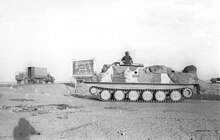BTR-50
The BTR-50 (BTR stands for Bronetransporter (Russian: БТР, Бронетранспортер), literally "armored transporter") is a Soviet tracked amphibious armored personnel carrier (APC) based on the PT-76 light tank chassis.
It has the ability to transport up to 20 fully equipped infantrymen, who sit on benches that run across the full width of the troop compartment.
[4] The driver sits in the center of the front of the hull and has three vision blocks and periscopes located at the top of the sloping glacis plate.
The commander, who sits on the left side of the vehicle at the front, has three vision blocks and periscopes in a projecting bay.
[4] The torsion bar suspension consists of six evenly spaced large rubber-tired road wheels with a drive sprocket at the rear and an idler at the front.
The first and last road wheels have a hydraulic shock absorber, the steel tracks have a single pin and 96 links each when new.
The vehicle can negotiate 30° side slopes, ascend 60° gradients, cross 1.1 m high vertical obstacles and 2.8 m wide trenches.
The APC has a five gear manual shaft-type transmission system similar to that in the T-34/85 medium tank.
The vehicle has a side clutch that enables it to make turns, mechanical transmission and a bandbrake.
The BTR-50 is amphibious thanks to its flat, boat-shaped hull, which is hermetically sealed and ensures minimal resistance when the APC is afloat.
The vehicle's low freeboard of 15 to 20 cm and lack of a snorkel means that it can only swim in the calmest waters.
It served in the motorized rifle regiments of tank divisions and mechanized brigades in the Soviet and East German armies.
During Operation "Raviv" (September 8–9, 1969), an amphibious raid across the Suez Canal, three T-54 tanks and six BTR-50s were used to wreak havoc behind Egyptian lines.
In February 2023 it was reported that Russia had reactivated some BTR-50s from storage and deployed them during the Russian invasion of Ukraine.
[7] In October 2023, the first example of a Russian BTR-50 being deployed in frontline combat in Ukraine appeared, with at least one BTR-50 being visually confirmed as destroyed by Ukrainian anti-tank mines northeast of Avdiivka in Donetsk Oblast during a large-scale Russian offensive against the city.
The automatic grenade launcher has a maximum range of 1,700 m.[4] The vehicle uses a number of instruments with its armament.
The vehicle has a new system of air intakes and exhausts on the left hand side of the front of the engine deck.
This vehicle has a greater combat capability, lower fuel consumption and a higher power-to-weight ratio.















